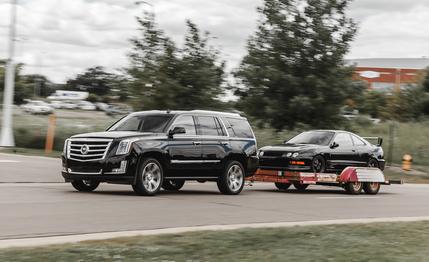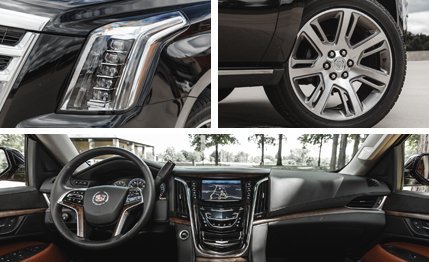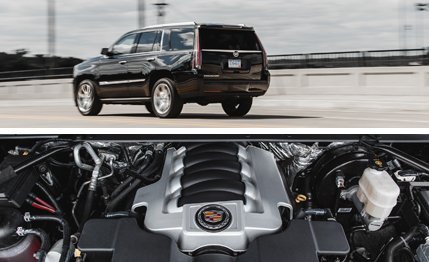 Instrumented Test
Instrumented Test
Cadillac has never shied away from size and mass. As early as 1930, there were Cadillacs that weighed more than three tons—and those were cars. Cadillac trucks wouldn’t be along for another seven decades. In the ’30s, Cadillac propelled its biggest classics-to-be with V-12 and even V-16 engines. You could time a zero-to-60-mph run with an alarm clock, but that was about as good as it got unless you wanted to pop for a Duesenberg.
Now Cadillac’s biggies are the Escalade and the long-wheelbase Escalade ESV. These body-on-frame trucks have entered their fourth generation of production since 1999. They share their foundations with the redesigned Chevrolet Tahoe, Chevrolet Suburban, GMC Yukon, and GMC Yukon XL. The new standard Escalade is 1.4 inches longer, 1.5 inches wider, and about 100 pounds heavier than last year’s example.
GM’s antidote for the increased dimensions and mass (5870 pounds total in our 4WD test unit) is a re-engineered version of its 6.2-liter pushrod small-block V-8. With refinements that include direct fuel injection, output improves from 403 to 420 horsepower and torque increases from 417 to 460 lb-ft. Performance in the EPA test cycle is also improved, yielding a rating of 14 mpg city and 21 highway. But as the feds love to say, your mileage may vary. We logged 14 mpg in our mostly suburban and country travels. To be fair, this included some miles towing a trailer, but the bottom line is that fuel economy should be viewed only in reference to other big SUVs in this class.

While thirst will always be an issue with such models, the Escalade’s hustle is not. Overcoming inertia in a 5870-pound wagon (not including passengers and cargo) is a big job, but the new 6.2-liter won’t be left behind when the light turns green. The big Caddy sprinted from zero to 60 in 6.1 seconds, pretty brisk for nearly three tons, and it’s also a small improvement over the previous generation’s 6.3-second 0–60 time.
The six-speed automatic smoothly optimizes the 6.2’s robust output. Would it be better with the impending GM eight-speed auto? Probably. But it’s hard to imagine anyone perceiving the current six-speed as unsatisfactory, although its manual-gear-selection button on the column shifter is awkward to use.
The engine technology made steady gains, but the same can’t be said for braking—mass at speed has plenty of inertia. The Escalade’s braking system is robust—not a hint of fade—but stopping from 70 mph takes almost two-thirds of a football field. We think a vehicle that’s likely to include kids on its cargo manifest should do better.
Inertia asserts itself in handling dynamics, of course. There’s substantial roll stiffness in the suspension tuning—perhaps at some small cost to ride quality (the Yukon Denali may be a smidge smoother)—so the big Caddy rolls less than you might expect in hard cornering. But transient responses are deliberate, and those 22-inch wheels ($500 extra) don’t help, as the suspension must control lots of mass moving up and down. There are also occasional quivers in this chassis on rough stuff. The electric power steering is nicely weighted but numb on-center, and it’s slow at 3.4 turns lock-to-lock. Altogether, the Escalade’s dynamic scorecard adds up to competent.

Other than its acceleration performance and towing ability (8100 pounds), the Escalade’s strongest suits are styling and interior design. The sheetmetal is all-new for 2015 but retains those Art and Science creases and sharp edges that put Cadillac on the road to recovery more than a decade ago, amplified by stacks of LEDs front and rear. Exterior design chief Bob Boniface says the redesign is “undeniably and unmistakably a Cadillac.” No argument there.
The interior in our Premium model was handsome indeed, black set off by dark saddle-tan leather ($2000). The seats were heated and ventilated, of course. Other features in the inventory included a power rear liftgate, power-folding third-row seatbacks, orchestral-quality audio, a second-row DVD entertainment system, a color head-up display, and a big (12.3-inch) center dash screen that’s home to an excellent navigation system. Unfortunately, in addition to navigation, that screen shares space with the CUE system (Cadillac User Experience), a secondary infotainment control matrix that’s initially frustrating, diminishing to annoying once the operator acquires experience.
With a base price of $72,690 for a “standard” two-wheel-drive model, the Escalade is the most expensive vehicle in the current Cadillac lineup, and our not-quite-range-topping $87,985 Premium-trim AWD tester is even more so. A Yukon Denali offers many of the same features, as well as the same powertrain, for far less money.
But there’s no denying the Escalade’s edge at the curb. Attitude matters in this game, and this Cadillac has an imposing presence.